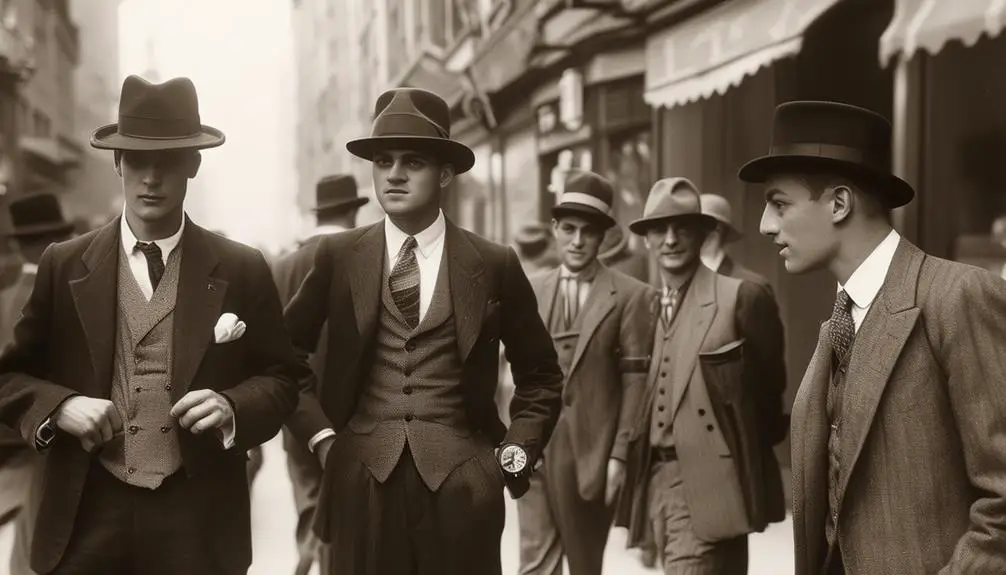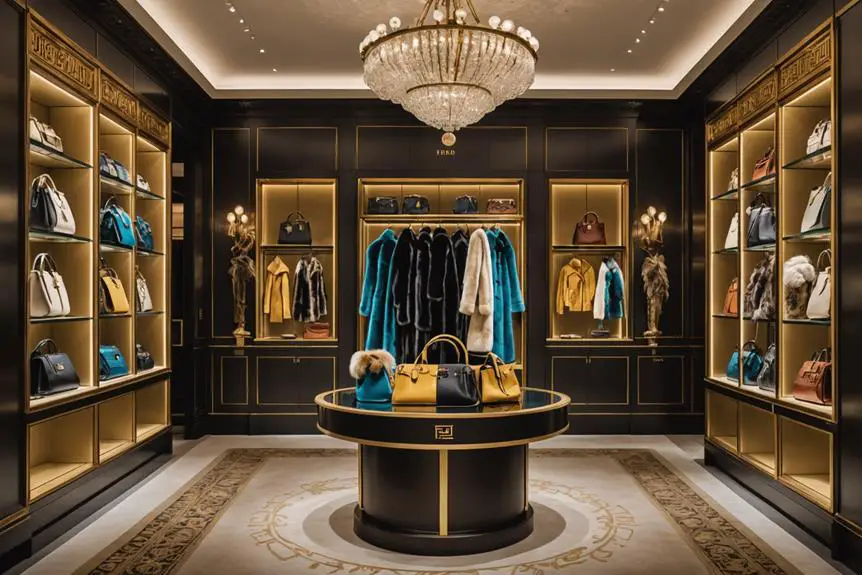Men's hats in the 1920s were more than mere fashion statements; they defined social identity and status. You'd likely see fedoras, blending sophistication with versatility, suitable for various occasions. The bowler hat illustrated the shifting class dynamics of the era, while the flat cap offered a casual look for the working class. Styles like the Homburg and top hat epitomized elegance during formal events. Each hat required proper sizing for comfort and style, making fit essential. As these trends continue to influence modern fashion, discovering more about their impact reveals fascinating connections to today's styles.
Overview of 1920s Men's Hats
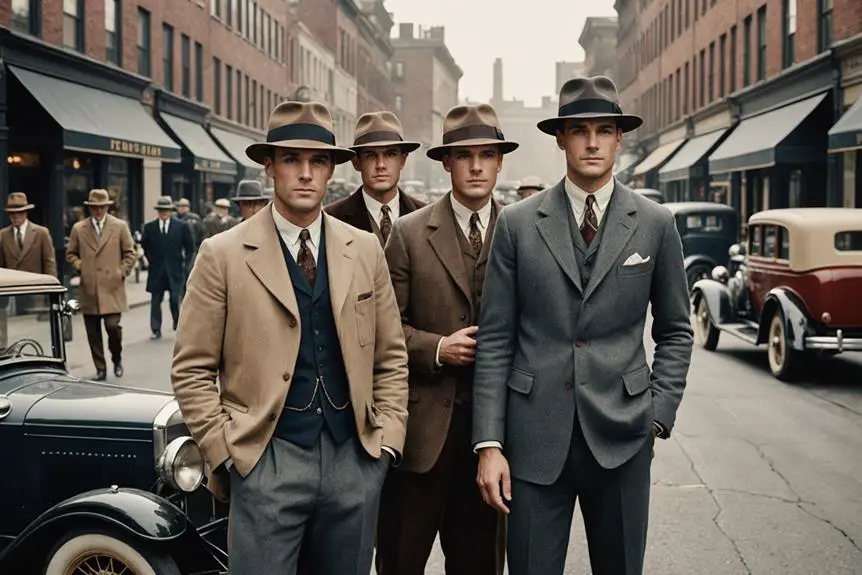
In the vibrant tapestry of the 1920s, men's hats stood out not just as fashion statements but as reflections of social identity and status. The era showcased a diverse array of styles, with each hat telling its own story. The fedora, for instance, emerged as a symbol of sophistication, characterized by its soft brim and indented crown, often crafted from felt for both warmth and elegance. You might encounter gentlemen at social gatherings donning a felt fedora, epitomizing the upscale vintage style of the decade.
Conversely, the bowler hat, originally designed for the working class, gained traction among the elite. Its rounded crown and narrow brim made it a staple for the refined gentleman, blending utility with fashion. Then there's the flat cap, popular among boys and the working class, providing a casual yet stylish option with its round body and stiff brim. Hats in the 1920s weren't mere accessories; they were essential components of both formal and casual outfits, embodying the spirit of the Great Gatsby era and showcasing individual style in a society deeply entrenched in social stratification.
Popular Hat Styles
The 1920s brimmed with distinctive hat styles that defined men's fashion and social standing. The Fedora emerged as a hallmark of sophistication, featuring a soft brim and indented crown, often crafted from felt. This versatility made it suitable for various occasions, blending seamlessly into both casual and formal settings.
In contrast, the Bowler hat, with its rounded crown and narrow brim, initially catered to the working class but evolved into a symbol of respectability among gentlemen. This shift illustrated the fluidity of class distinctions during this vibrant decade.
For a more relaxed vibe, the Newsboy cap gained popularity, celebrated for its casual yet stylish appeal, becoming a favorite among young boys and working-class men. Meanwhile, the Homburg hat, crafted from rich beaver fur felt, stood as a formal choice, associated with the upper class and elegance.
Lastly, the Top Hat, towering and cylindrical, epitomized high status, primarily donned during formal occasions. Each of these styles contributed to the evolving landscape of men's fashion, showcasing how hats not only complemented outfits but also conveyed social messages.
Sizing and Fit Guide
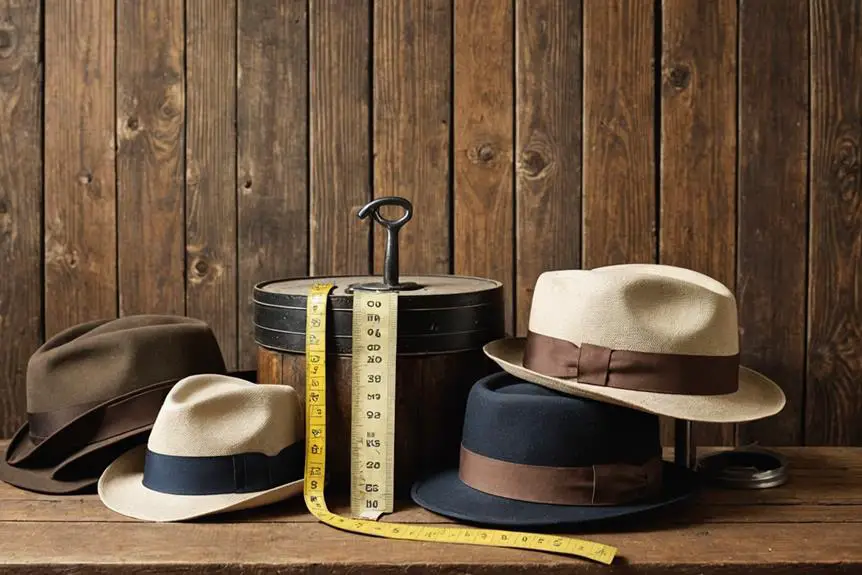
Finding the right fit for a hat is vital to guaranteeing both comfort and style. When selecting a men's fedora or any other hat, understanding sizing is essential. Start by using a sizing guide to accurately measure your head circumference. This simple step promises a snug fit, which not only enhances comfort but also elevates the overall look of the hat. Vintage clothing labels often provide critical insights into sizing and fit, making the understanding of these details even more important for collectors and fashion enthusiasts vintage clothing identification.
Custom sizing options are available, accommodating various head shapes and sizes. Whether your choice is a felt hat or a luxurious Beaver Fur creation, a proper fit is paramount. The brim typically plays a significant role in how the hat sits on your head; if it's too loose or tight, the hat can lose its intended flair.
For a seamless shopping experience, conversion charts for U.S., U.K., and international sizes simplify the process. You'll find that tools provided by retailers can make finding the perfect hat size hassle-free. By prioritizing fit and comfort, you guarantee that your chosen hat not only complements your outfit but also reflects your personal style. So take the time to measure accurately, and you'll wear your hat with confidence.
Shipping and Returns
Shipping men's hats from the 1920s collection is streamlined and customer-friendly, ensuring that your chosen accessory arrives in pristine condition. With a focus on quality and service, you can expect the following benefits when ordering your Bollman Heritage Collection Fedora or any Fedora Hat For Men:
- Free worldwide shipping on all orders
- Durable boxes and eco-friendly bags for protection during transit
- Expedited shipping options for urgent needs
- Hassle-free returns with simple instructions
Every hat is shipped with care, utilizing durable boxes that safeguard against damage. Eco-friendly bags further enhance the experience, reflecting a commitment to both quality and sustainability. If you ever need to make a return or exchange, a dedicated portal simplifies the process, allowing you to manage your orders effortlessly. You'll find clear instructions that make returns straightforward, eliminating any stress associated with the process.
Whether you're gearing up for a special occasion or looking to make a statement, you can shop confidently, knowing that your men's hats will arrive swiftly and safely, ready to elevate your style.
Pricing and Availability
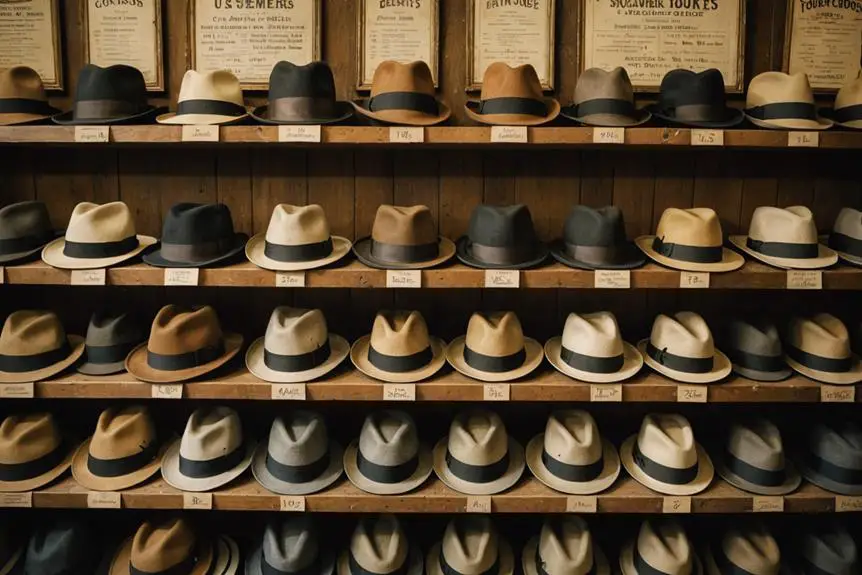
With your new men's hat on the way, it's important to contemplate the pricing and availability of these stylish accessories. In the 1920s, you'll find that men's hat styles, particularly Fur Felt fedoras and Homburg hats, range from approximately €215.00 to €315.00. This pricing reflects the high-quality materials and craftsmanship that go into each piece, ensuring you're investing in elegance and sophistication synonymous with the Roaring Twenties.
Availability varies, as certain styles may be in high demand. Limited edition hats, for instance, often come at a premium price and encourage prompt purchases, given their exclusive nature. If you're looking for something unique, keep an eye out for these special offerings.
Additionally, new arrivals are regularly added to collections, ensuring a fresh selection for discerning customers like you. This constant influx of designs means you can always find something that resonates with your personal style. Whether you're drawn to the classic fedora or the distinguished Homburg, understanding the pricing and availability will help you make an informed choice, ensuring your hat complements your wardrobe perfectly.
Modern Style Impact
The modern resurgence of men's hats, particularly styles from the 1920s like fedoras and bowlers, showcases how historical fashion continues to influence contemporary wardrobes. This revival is heavily influenced by cultural phenomena, such as the popular television series *Peaky Blinders*, which has reignited interest in vintage aesthetics.
Today, you'll find that various styles, including:
- Fedoras with wide brims
- Classic bowlers
- Small-brim flat caps
- Straw Panama hats
These pieces not only enhance your outfit but also serve as symbols of sophistication and social identity. Modern fashion designers frequently incorporate classic elements from the 1920s into their collections, blending these timeless styles with today's trends.
The craftsmanship of these hats, often made from quality materials like wool felt and beaver fur, justifies their higher price points. As men increasingly seek to express their personal style, 1920s-inspired hats have become staples in both casual and formal settings. This blend of historical influence and modern fashion reflects a growing appreciation for the past while adapting to contemporary tastes.
Frequently Asked Questions
What Kind of Hats Did Men Wear in the 1920s?
In the 1920s, you'd see men sporting various hats like Fedoras, Bowlers, and Flat caps. Each style reflected personal taste and social status, showcasing sophistication, casual elegance, or formality, depending on the occasion.
What Are the 1920S Hats Called?
You'll find the 1920s hats referred to as Fedoras, Bowlers, Flat Caps, Homburgs, and Panamas. Each hat reflects distinct styles and social statuses, showcasing the era's diverse fashion trends and cultural influences.
What Are Gatsby Hats Called?
Gatsby hats, often referred to as Fedoras, embody sophistication with their soft brims and indented crowns. You'll find they effortlessly blend style and versatility, making them a timeless choice for both formal and casual occasions.
What Were Men Wearing in the 1920s?
You'll notice men in the 1920s embraced tailored suits, crisp shirts, and polished shoes, reflecting sophistication. Accessories like pocket squares and ties completed their look, embodying the era's spirit of elegance and social status.
